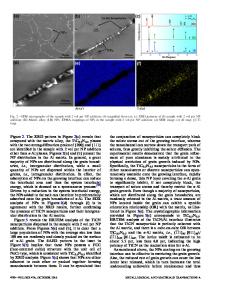Grain refinement in 7075 aluminum by thermomechanical processing
- PDF / 2,626,249 Bytes
- 10 Pages / 594 x 774 pts Page_size
- 60 Downloads / 342 Views
GRAIN
refinement frequently results in beneficial changes of mechanical properties in metals. Since the pioneering work of Hall I and Petch, 2 many investigators have verified the increase in macroscopic yield strength which is caused by grain refinement) Properties such as fatigue life, ductile-to-brittle transition temperature and fracture toughness are also affected by grain refinementf1-5 although grain size effects on these properties have received less attention than yield strength. Another significant change produced by grain refinement is its effect on the character of deformation at high temperatures. At temperatures above about half of the absolute melting temperature and slow strain rates, grain boundary sliding can make a substantial contribution to the total strain, provided that the grain boundary area is large. 6: Under the proper conditions of temperature and strain rate, such materials exhibit large elongations prior to failure during tensile deformation; these materials are termed superplastic. The phenomenon of superplasticity requires a fine grain size; typically the mean grain diameter must be less than about 10 ~m for superplastic behavior to be observed. 6,7 Previously developed processing techniques for grain refinement of medium to high strength aluminum alloys are of two basic types.* One class of *Several eutectic aluminum alloys such as AI-Cu and A1-Mg may be processed to achieve fine grain sizes but their room temperature strengths are low.
J. A. WERT is Member, Technical Staff, Physical Metallurgy Group, N. E. PATON is Director, Materials Synthesis and Processing, C. H. HAMILTON and M. W. MAHONEY are Principal Scientist and Senior Staff Associate, respectively, Metals Processing Group, Rockwell International Corporation, Science Center, P. Oo Box 1085, Thousand Oaks, CA 91360. Manuscript submitted July 8, 1980. METALLURGICAL TRANSACTIONS A
thermomechanical treatments is capable of reducing the size of certain aluminum alloys during the first stages of high temperature deformation. 8,9 These processes begin with casting procedures and heat treatments which produce special distributions of solute species and precipitates. Subsequent warm working (rolling) produces a complex, partially polygonized dislocation structure. Prior to the onset of deformation at high temperatures, the precipitate and solute distributions resist discontinuous recrystallization. Instead, the dislocation cell structure recovers continuously to form a network of sub-grain boundaries which is stabilized by the particle dispersion. High temperature deformation is necessary to complete the continuous recrystallization process. The other class of grain refining processes has been applied to standard, high-strength aluminum alloys. This class of processing techniques involves a series of heat treatment and deformation steps intended to produce a fine grain size by discontinuous recrystallization. These processing schedules are often termed "Intermediate Thermal Mechanical Treatments" or ITMT. A number of ITMT process
Data Loading...











